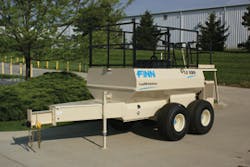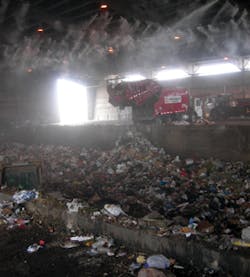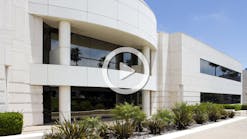When I was a young man first learning how to use power tools, my father’s most important words of advice to me were to keep my workbench and work shop area clean and free of sawdust, shavings, and misplaced tools. Keeping the workbench clean was the first and most important step to keeping it safe.
The same principle applies to every other work environment, including construction sites, factory floors, and transfer stations and MRFs in the waste management industry. What needs protecting at a transfer station or MRF? Who needs to be kept safe? The answer to both questions, in the words of most environmental regulations, is “human health and the environment.”
Transfer stations and MRFs are difficult work environments, with the potential for pollution spills, fires, dust, and odors. Spills are usually contained by the structural elements of the facility, with containment curbing and sloped floors directing spills to inlet grates and spill collection sumps. Fire protection is provided by the site’s hydraulic system, providing sprinklers that spray water when needed in accordance with the local fire codes.
Dust and odor control, however, is more operational in nature, requiring additional systems to those found in most industrial or commercial buildings. Though not typical, each type of control is essential to the safe and clean operation of transfer stations and MRFs.
Similarities and Differences
Simply stated, transfer stations and MRFs operate almost as mirror images of each other. Transfer stations collect multiple wastestreams into a single waste mass for long-distance shipping to final disposal in a landfill. MRFs take a single incoming waste mass and separate out its individual waste types for recycling and resale on the scrap market. Transfer stations save money by reducing overall waste hauling costs. MRFs make money via the sale of recycled materials. Aside from the possible use of a hydraulic ram to achieve maximum waste densities for shipping, transfer stations don’t utilize much in the way of automated equipment. MRFs, on the other hand, can utilize a complicated series of automated equipment and processes to separate waste into individual types.
Both types of facilities have similar problems in regards to dust containment and odor control. The waste material they both process, by its very nature, tends to emit large quantities of dust particulates and significant release of odors. How each system operates depends on the differences between the structural layout and operational configuration of transfer stations and MRFs.
Transfer Station Design and Operation
Transfer stations are the simpler of the two types of facilities. Serving as a focal point for multiple trash hauling routes, waste collections trucks converge on transfer stations and deposit their refuse on its tipping floor. A typical tipping floor has a minimum area that measures about 4,000 square feet (about 65 feet by 65 feet). As a general rule of thumb, the size of the tipping floor should be increased by an additional 20 square feet for every ton of waste received by the transfer station per day.
For example, a transfer station with a pass-through capacity of 200 tons per day (requiring an additional 4,000 square feet at 20 square feet per ton) should have a total tipping floor area of 8,000 square feet. While the tipping floor mostly defines the extent and dimension of the transfer facility, the actual transfer site design would allow for potential future expansion, access roads, sound and sight buffers, perimeter security, employee parking, additional office and storage space, and truck queuing (preventing a line of waste trucks from backing up onto the adjacent city streets).
The actual design of the transfer station depends on its intended operational configuration. Simpler designs combine a tipping floor and an open-topped transfer trailer parked in a lower bay. Waste that has been deposited onto the tipping floor is pushed into the top of the transfer trailer by a front-end loader. Another possible design avoids depositing waste onto the tipping floor and instead allows waste truck operators to use the tipping floor to back their trucks up to the edge of the bay for direct dumping into the transfer trailer.
Some transfer station designs utilize a surge pit, which is an intermediate floor level between the tipping floor and the transfer trailer bay that allows for the temporary storage of peak waste loads. By temporarily storing peak loads, the number of needed transfer trailers can be reduced along with the size of the bay. A surge pit also allows some preliminary waste compaction as the front-end loader or dozer pushes the waste up against the confining walls of the surge pit. This increase in waste density further increases the number of trailer trucks required for long distance hauling from the transfer station.
A simple surge pit can be transformed into a true waste compaction unit by the addition of hydraulic rams, precompactors, and bailers. Installed sideways into surge pit walls, hydraulic rams drive the waste pile into the back of a specially designed trailer. Precompactors are set inside a confining cylinder and create a high-density waste “log” that later can be loaded into the back of a trailer by means of a live floor. Bailers are fed waste from the tipping floor and create dense bricks of waste that can be loaded into a trailer truck or flatbed truck by an overhead claw or a forklift.
Finn Corp.’s LF120 HydroSeeder is designed for use in the extreme environments of landfills.
Overall sizing of the transfer station can be based either on the rate at which waste can be unloaded from the collection trucks or on the rate that transfer trucks can be loaded. The first is a function of the collection vehicle payloads, the areas of the dumping space, hours per day of operation, time to offload a collection truck, and a “peaking factor” (the ratio of the peak number of trucks versus the average number of trucks during a 30-minute portion of the workday). The second is determined by the transfer trailer capacity, the number of trailers than can be loaded simultaneously, hours per day of operation, the time to load each trailer, and the time needed to position and park each trailer.
There are other siting considerations besides truck queuing requirements. The general location should be chosen to minimize overall hauling costs. The transfer station’s property should be large enough to enclose all its buildings and operations. Security and visual screening are of prime importance to mitigate public opposition to the transfer station’s location.
MRF Design and Operation
Though having a function that is a complete opposite of a transfer station, and therefore a different design, a MRF can have similar siting requirements. There are two types of MRFs, the simple multistream “clean” MRF, and the more complicated, single-stream “dirty” MRF. The clean MRF accepts multiple streams of waste that have already been segregated by homeowners and businesses into the various types of recyclable materials prior to hauling. This makes recyclable materials simple to sort, collate, and organize. Therefore, a clean MRF can rely mostly on human labor and simple equipment instead of complicated processing machinery.
Having to separate a complicated, single incoming wastestream, dirty MRFs use a wide array of mechanical equipment modified to segregate and sort out different types of recyclable materials. The stages of separation can vary somewhat from MRF to MRF but the basic equipment tends to be the same. Ferrous metals are removed by magnetic separators, either overhead magnets that directly extract the metals or magnetic belts to which the metal objects adhere as the rest of the wastestream goes on to the next removal stage. Nonferrous metals are removed by eddy-current separators, which induce magnetic currents and magnetic fields by means of rapidly spinning magnetic rotors. Large, lightweight objects like cardboard boxes are removed by disc screens, which induce a wavelike motion that carries these large objects to the top of the wastestream for easy removal. Small objects that are not easily recyclable but have to be removed from the wastestream are extracted by rotating trommels (large, perforated canisters that allow fines to escape). Such lightweight objects as sheets of paper can be removed by air classifiers, essentially blowers that carry paper to the top of chimney sack for removal, and air knives that create high-pressure air blasts forming sheets of airflows. Finally, glass color separators use light spectrophotometry to separate glass and plastic by color.
Like transfer stations, MRFs have a tipping floor where the waste is initially deposited. The size of a MRF
Transfer stations collect multiple wastestreams into a single mass for shipping to a landfill.
tipping floor also depends on the projected waste receipt rate. However, since waste deposited at MRFs may take a longer time to process, a MRF tipping floor typically needs an additional two days of surge capacity and enclosure walls to contain the stockpiled waste.
Unlike a transfer station with its truck parking bays, the portion of a MRF apart from its tipping floor is given over to processing equipment. A series of heavy-duty belts carry waste from one processing station to another. Hooks and blades set above the belts slice open trash bags, allowing access to the moving waste. Belts can be inclined, connecting processing stations located on different floors. This allows for multifloor facilities with relatively small architectural footprints overall. The processing stages should be sequenced so that the easiest-to-remove materials are extracted first. Ideally, the materials most difficult to extract should not be extracted at all but should remain as residual materials on the belt at the completion of the recycling process.
Once extracted, separated, and individually stockpiled, the various materials have to be prepared and loaded for shipment to the resale market. This is done by appropriately sized and configured compactors and bailers. The resulting compressed “bricks” of materials (e.g., cardboard, aluminum cans, newsprint) are then delivered to trucks parked in adjacent loading bays.
Overall facility size varies with waste load rates, with a typical area of 1,000 to 4,000 square feet per ton of waste. As noted above, this area can be spread over multiple floors. An additional 100,000 square feet (about 2.5 acres) outside the facility will be required for scales, truck queues, security, setbacks, etc. Another 5 acres will be required for parking rolling stock, one-half to 1 acre for employee vehicle parking, and 3 acres for buffer and visual screening.
In Confined Spaces
Mark Kestner, Ph.D., of National Environmental Service Co. Inc., has the following dust control recommendations for plant managers, practical advice equally applicable to odor control:
“Good process control and good dust control are just two sides of the same coin. And I don’t use that term loosely. There are lots of ways to make more money by complying with regulation. Some customers like wetter base rock and water going across the scale can pay for a spray system in a couple of years. I know of several examples where mines have been paid to use waste products as dust suppressants-especially for roads. This allows the chemical company to avoid the higher cost of disposal by burial or incineration. Many cement companies profit from burning hazardous wastes or tires; quarries can profit by using off-spec or waste chemicals… One of the most effective tools that you can use to control dust is good operating practice. I’ve always been impressed by the great diversity of methods and machinery used to produce sand, stone, and gravel. Every plant seems to do something just a little bit different. But one thing all plants that have successfully complied with air-quality standards have in common are operators that have been trained to take personal responsibility for dust control. They are your front line in the battle to protect the environment and improve production.”
When it comes to defending a MRF from dust, the best defense is usually a good offense. The approach taken by Bulk Handling Systems (BHS) is to attack it aggressively at the source. This attack involves three phases. The first phase is that of containing the dust at areas of the process that agitate the material, such as the infeed region and areas above the disc screens (OCC Separator, NewSorter screens, and Polishing Screens). For these applications, BHS provides a rigid, steel enclosure that completely surrounds the screen surface. The second phase involves collecting the dust. BHS equipment comes complete with ventilation systems to draw the dust out of the dust hood enclosures. In the third phase, dust is filtered out of the air stream by dust filters (baghouses), where filter bags clean the exhaust. The dust is collected in the bottom of the dust collector for disposal while clean air is vented outside. In addition to these direct approaches, BHS helps its customers control dust by designing work areas with separation walls between the tipping floor and the main areas of the MRF and including enclosed cabins for sorting personnel. These cabins protect sorters from exposure to dust and noise while providing improved visibility from lighting and comfort from HVAC.
Manufacturers and Suppliers
Aeromist is the world’s largest supplier of misting systems, fogging systems, and accessories. The company’s high-pressure misting systems provide an effective solution for dust suppression. These systems work by implementing products designed to attract and neutralize dust particles resulting from most industrial and mining processes as well as waste transfer plant operations. Aeromist dust control systems are custom-designed and engineered to exceed the EPA PM 10 standards for dust suppression. High-pressure mist systems produce 10-micron water droplets that attract, suppress, and remove fugitive dust particles through the process of agglomeration. The dust particles will drop harmlessly from the air without wetting the area. The company’s high-pressure, stainless-steel mist system is designed with custom spacing and nozzle sizing. This configuration effectively suppresses dust particles, allowing waste transfer plants to continuously meet compliance standards for EPA and state health regulations.
Air & Water Systems is mostly known for its line of humidifiers and misters, but it also produces the AirClean HP air filtration system for dust removal. Utilizing a three-stage filter system, the filters are designed for quick and easy replacement. The first-stage filter is a washable electrostatic filter that comes as standard equipment. The second-stage filter is a MEREV 14 per ASHRAE 52.2 bag filter that captures 99% of particles as small as 5 microns and 91% of particles as small as 1 micron in size. The final filter is the diffusing filter with a mixing chamber that enables the exiting air to be dispersed across the entire surface area of the diffusing filter. This feature creates the proper airflow patterns necessary for trapping microscopic dust. Optional charcoal filters can also be installed.
Benzaco Scientific makes and supplies chemicals for neutralizing noxious odors. As a delivery system for these chemicals, Benzaco also supplies high-quality automated odor control systems. These systems are designed for minimal maintenance, avoiding rusted plumbing, clogged nozzles, and inferior, thin-walled tubing. The company’s chemicals are formulated for waste industry applications.
Buffalo Turbine LLC has been manufacturing high-volume, high-powered turbine-style blowers for debris maintenance and spraying since 1945. Manufactured in the United States, Buffalo’s products are well known in the waste and recycling industry for airborne dust control and the portable nature of the equipment. “Offering simple, cost-effective equipment that creates a safe and healthy environment for waste industry workers and surrounding communities is the key, and Buffalo Turbine has been a leader in this technology for many years,” says Paul Syracuse, general manager. The Buffalo Turbine Monsoon Misting systems are capable of producing billions of tiny water droplets for trapping airborne dust generated by many different processes in the waste industry.
The heart of Buffalo’s Monsoon system is its gas-, diesel-, electric-, or hydraulic-driven turbine blower that atomizes water fed from a standard three-quarter-inch waterline and then passed through a proprietary gyratory atomizing nozzle. The Monsoon is available with a variety of mounts, allowing it to be used as a stationary misting system or moved from site to site, depending on requirements.
Ecolo manufactures proven systems and chemistries for core global channels, including solid waste facilities. Ecolo allows site operators to effectively and economically reduce offsite odor complaints by misting/fogging AirSolution neutralizers and reactants or topically applying foaming BioStreme products. Ecolo products can be applied in the following trouble areas: the facility perimeter, working area and tipping floor, access roads and scales, leachate management systems, and storage facilities. The most common odor-causing compounds for solid waste facilities are hydrogen sulfide, sulfur dioxide, ammonia, and methyl mercaptan. Ecolo’s chemical solutions are designed to react with and neutralize these odor-causing compounds.
MicroCool’s industrial fogging systems include humidification, process cooling, and the suppression of dust and odor. The company’s dust suppression systems use 10-micron fog droplets to trap dust particles (as small as PM10 and sub PM10 dust particles, which are routinely monitored by authorities) and drop them harmlessly to the ground for recovery. Transfer stations and waste processing are the major clients for these applications, but fine-dust suppression systems can be applied to many different industries. The MicroCool high-pressure system is also used to distribute suitable odor control chemicals into the air to suppress airborne malodors.
NCM Odor Control manufactures odor and dust control products at its ISO-certified 901:2008 factory. These products control odors from MSW, compost, leachate, and other materials. Odor control systems can range from a simple unit that turns on and off and has a digital timer to eliminate human need, to a multizone remote-control system that gives sites complete control over the system. Multizone systems are engineered to give site operators total control with the system. This minimizes water consumption, for which sites get charged, and minimizes odor control product consumption. The multizone system designates specific areas of the system (e.g., tipping floor, doors, load-out pits) to their own zone. Multizone systems can be controlled via remote controls or with ball valves. Multizone systems allow direct control over which spray nozzles are to be used. The company’s spray systems use a high-pressure atomizing technology to ensure a minimal amount of moisture, if any at all, hits the floors when treating areas such as tipping floors. NCM’s SL-4000 odor neutralizer interacts synergistically with odor molecules. The Eco-Zyme neutralizer is specifically designed to eliminate odors from compactors and trucks, making it ideal for MRFs and transfer stations.
The National Environmental Service Co., or Nesco, manufactures a fog generator that is a state-of-the-art dust control system. It creates an ultrafine mist (10-micron droplets and smaller) that attracts and holds dust particle so they agglomerate and settle out of the air quickly. The generators are effective either by themselves or as auxiliary units to larger cyclone systems. The systems require no compressed air or chemicals, but they do use conditioned water to prevent clogging. They operate most effectively in enclosed areas like transfer stations and MRFs.
OMI Industries supplies Ecosorb, an all-natural odor control product that has zero toxins or harmful VOCs, utilizing molecular bonding to eliminate odors. Ecosorb can be delivered in a variety of ways, including atomization, vaporization, as an additive, or in gel-coating formulation. Vaporization is an earth-friendlier option because it uses zero water. Instead, undiluted Ecosorb products are pumped through a perforated distribution system. The pressure and gauge of the perforations create a “dry mist” that neutralizes odors. For airborne odor treatment, Ecosorb products are mixed with water, pumped through pipes or hoses, and delivered via nozzles or fans to the affected areas.
Rusmar Inc., of West Chester, PA, has become a leading provider of foam and application equipment for alternate daily cover (ADC) in municipal solid waste landfills and for the control of odor, dust, and VOCSs during hazardous waste remediation efforts. Its AC-667-SE soil equivalent foam is a liquid concentrate composed of a starch-modified hydrolyzed protein surfactant. It is delivered in bulk quantity and diluted with water prior to application. AC-667-SE was developed specifically to meet and exceed all the requirements of RCRA, Subtitle D. The foam forms a complete barrier to control disease vectors, odors, fires, and windblown litter, and to prevent scavenging. In addition, AC-667-SE is nontoxic, nonhazardous, inflammable, and biodegradable, thereby posing no threat to human health or the environment. The material will adhere to vertical and sloped workfaces. The foam has been approved for use up to 48 hours and will consume zero airspace when covered with waste. Additionally, it is effective for use year-round regardless of ambient temperature and has the ability to withstand even moderate rainfall. This ability to work even during precipitation events greatly increases its operational usefulness. AC-667-SE is applied with a pneumatic foam unit, PFU2500/60. The PFU2500/60 is a self-propelled foam machine built with Caterpillar components and ease of use in mind. It is designed to be driven over the workface while deploying a 12-foot-wide foam blanket via a patented bi-directional manifold. Onsite storage is provided by the bulk storage and dilution system, BSD7000. With a connection to a customer supplied water source, the BSD7000 provides the operator with an easy-to-use dilution and filling system. A typical 10,000-square-foot workface can be foamed in 20 minutes. The recommended coverage depth is 3-4 inches, provided the workface has been properly compacted and groomed. Additional operational flexibility is provided by a heating unit for use in cold weather. AC-667SE stays moist throughout its life with a consistency similar to that of shaving cream. There is no curing time for the product.
St. Croix Sensory Inc. is a testing and training company and an odor-testing lab. Its main service is the testing and evaluation of air samples collected in sample bags by others. Its odor evaluation procedures are in accordance with ASTM International (ASTM) and the Committee for European Normalization (CEN). The odor testing is performed by trained human assessors. They also provide instruments such as the AC’SCENT Laboratory Olfactometer for onsite testing. This device is standard for use in all USA and Canadian university odor laboratories, as well as a number of odor laboratories around the world. St. Croix’s Nasal Ranger field olfactometer is used by regulatory agencies, researchers, engineers, and the owners and operators of landfills, compost facilities, wastewater treatment facilities, and industries. The company also facilitates overall odor evaluation studies by hosting an Internet-based database, www.odor-gis.com, which automatically maps odor around a facility or in a community.
Walex Products Co. Inc. has developed commercial odor control solutions for landfills, transfer stations, and waste treatment facilities. These products reduce hydrogen sulfide and ammonia odors. Exodor Assure is this application for transfer stations and MRFs. Assure reduces airborne odors as it is sprayed in a diluted mix into the air as a mist. Its organic formula is nontoxic. It works with all types of portable and permanent atomizing systems and will not clog nozzles.
With special guards and skid plates to protect the engine and components, Finn Corp.’s LF120 HydroSeeder is designed specifically for use in the extreme environments of landfills. It is an efficient solution for applying ADC as well as materials to control odor, dust and erosion. Featuring a working capacity of 1,000 gallons and maximum material capacities of 3,200 pounds for granular solids and 500 pounds of fiber mulch, the LF120 will cover the average open face in less than 1 hour using only one tank load. A tower discharge distance up to 180 feet allows for efficient ground coverage.
Personal Safety and Protection
Global Sensor Systems Inc. meets the need for safety of heavy-equipment operations in enclosed areas such as a transfer station tipping floor. Mounted on the back of trash trucks or heavy equipment, the company’s infrared sensor system detects people in the path of the vehicle as it backs up. The system is available with or without automatic braking. The system is activated as soon as the vehicle’s transmission is shifted into reverse. Any subsequent change in gear will shut of the system. Braking also includes the sounding of a sonalert and the flashing of warning lights.
HexArmor manufactures a wide range of PPEs, including the 900 series cut-resistant gloves, cut- and puncture-resistant body protection aprons, Gator Grip gloves especially designed for slick surfaces found in the oil-and-gas industry, ultra-strong glove box gloves, heat-resistant Hotmil gloves, cut-resistant mechanic’s gloves, needle-stick-resistant gloves (important in any solid waste environment), and protective arm sleeves. HexArmor products with SuperFabric offer industry-leading cut resistance, exceeding both ISEA/ANSI and CE/EN388 level 5 cut-resistance. SuperFabric materials integrate commercially available materials with custom-proprietary armor technology to create award-winning textiles.
Intec Video Systems Inc. addresses problems encountered by waste truck operators on their routes every day. Operators face an obstacle course of parked cars, alleyways, and pedestrians, situations in which truck operators need to know what’s around their vehicles at all times. Intec’s rear- and side-vision camera systems address this problem. Designed for the highest sensitivity to the lowest light and the widest field of view available, in both color and black-and-white versions, operators can easily observe previously hidden areas surrounding a refuse vehicle. Tested to withstand all vehicle generated and environmental conditions, Intec’s safety camera systems are the highest-performing and longest-lasting systems available.
Preco Electronics has developed a new blind-spot-monitoring system specifically designed for the waste industry. The waste industry has continually been among the Top 10 dangerous professions ranked by the CDC for a number of years. At least 25% of their vehicle accidents are attributed to the blind spot. PreView WorkSight for waste provides a refuse truck driver with a robust, active warning solution that gives drivers the notice they need to react quickly and prevent accidents. The PreView system detects objects in blind spots, actively notifies operators, and helps drivers prevent accidents. The PreView Blind Spot Safety System’s two patented pulsed radar sensors consistently detect objects 20 feet away, providing an active audible and visual warning through an in-cab display unit to give drivers the critical extra seconds they need to react and avoid a collision. PreView’s waste management customers are reporting reductions of more than 75% in blind-spot accidents since installing PreView on their waste vehicle fleets.
Reflective Apparel Factory, of Marietta, GA, supplies visibility-enhanced apparel (VEA) utilizing Scotchlite reflective material. The company’s safety clothing includes waterproof hooded jackets, systems gear jackets, T-shirts, polo shirts, long sleeve T-shirts, sweat shirts, vests, public safety gear (for fire and police personnel), pants, rains suits, and headwear (broad-brim hats, baseball caps, hardhats, and knitted caps).
The Spraystream “fog cannon” is an odor and dust control system from Fogco Systems Inc. It has a spray range that is ideal for both indoor and outdoor use and provides access to advanced technology that efficiently and effectively suppresses dust and odor in most commercial and industrial applications.
The SprayStream creates a column of air that exits the cannon at high velocity and can travel distances in excess of 150 feet. When this dense spray of properly atomized water is introduced into the air column, the result is an effective means of dust suppression. Applications include waste transfer stations, recycling plants, mining operations, rock quarries, building demolition, steel and slag facilities, and construction sites. It comes in both wall-mounted and portable models. The wall-mounted units include the fog cannon housing with a high-velocity fan assembly, a 230-V or 460-V three-phase motor and a stainless-steel fog ring with oscillating nozzles allowing up to 270-degrees of coverage of up to 70,000 square feet.
Mounted versions are transported on a portable cart or trolley and can be moved within the facility from location to location as needed. The trolley includes the fog cannon assembly, the high-pressure pump, and the electronic control box.








